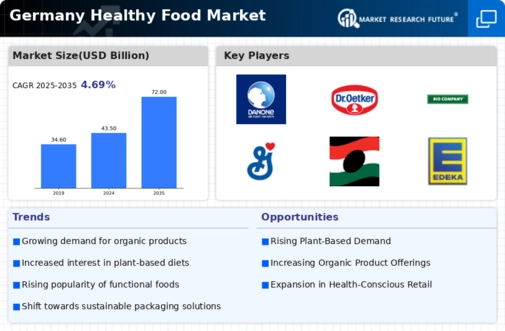Increasing Health Awareness
The growing awareness of health and wellness among consumers in Germany is a pivotal driver for the healthy food market. As individuals become more informed about the benefits of nutrition, they are increasingly opting for healthier food options. This trend is reflected in the rising demand for organic and natural products, which has seen a growth rate of approximately 10% annually. The healthy food market is experiencing a shift as consumers prioritize products that contribute to their overall well-being. This heightened focus on health is also influencing food manufacturers to innovate and reformulate their products to meet consumer expectations. Consequently, the industry is adapting to these changes by offering a wider range of health-oriented products, thereby enhancing market growth prospects.
Innovative Product Development
Innovation in product development is a key driver of growth in the healthy food market in Germany. As consumer preferences evolve, companies are increasingly investing in research and development to create new and exciting health-focused products. This includes the introduction of functional foods that offer additional health benefits, such as probiotics and superfoods. The healthy food market is witnessing a surge in demand for these innovative products, with a reported increase of 15% in sales of functional foods over the past year. This trend suggests that consumers are actively seeking products that not only meet their nutritional needs but also enhance their overall health. As a result, companies that prioritize innovation are likely to thrive in this competitive landscape.
Government Initiatives and Regulations
Government policies and regulations play a crucial role in shaping the healthy food market in Germany. Initiatives aimed at promoting healthier eating habits, such as the 'National Action Plan on Nutrition,' encourage consumers to make better food choices. These policies often include educational campaigns and subsidies for healthy food options, which can lead to increased consumption of nutritious products. The healthy food market benefits from these regulations as they create a more favorable environment for health-focused brands. Furthermore, stricter labeling requirements ensure transparency, allowing consumers to make informed decisions. As a result, the market is likely to see a rise in demand for products that comply with these regulations, fostering growth in the sector.
Rise of E-commerce and Online Shopping
The expansion of e-commerce platforms is significantly impacting the healthy food market in Germany. With the convenience of online shopping, consumers are increasingly purchasing healthy food products through digital channels. This shift is evidenced by a reported increase of over 25% in online grocery sales, particularly for health-oriented items. The healthy food market is adapting to this trend by enhancing online presence and offering a diverse range of products. E-commerce not only provides consumers with access to a wider selection of healthy options but also facilitates the delivery of fresh and organic products directly to their homes. This trend is likely to continue, as more consumers embrace the convenience and variety offered by online shopping.
Sustainability and Ethical Consumption
Sustainability concerns are becoming increasingly important to consumers in Germany, influencing their purchasing decisions in the healthy food market. There is a growing preference for products that are sustainably sourced and produced, reflecting a shift towards ethical consumption. This trend is supported by data indicating that approximately 60% of consumers are willing to pay a premium for sustainably produced food items. The healthy food market is responding to this demand by prioritizing eco-friendly practices and transparent supply chains. Brands that emphasize sustainability are likely to gain a competitive edge, as consumers seek to align their values with their purchasing choices. This focus on sustainability is expected to drive growth in the market, as more individuals seek to make responsible food choices.























Leave a Comment